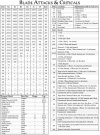A little background -- around 2007, we had the idea of using RMX to do a version of Cyradon for RM, and calling it RM Cyradon. We had the first draft ready to go (it just needed some final pagemaking) when Seal said we could not do it cause it would create another version of RM and confuse things (Seal said "two friends" told him this -- this later turned out to be the two idiots currently running ICE). So after much back and forth, I got permission to do a RM Revision. You can read the proposed product plan on my personal website -- https://www.wizlair.net/post.html?an roposed RM Revision Plan&fn=24April22 -- and in that product plan, I guestimated 128 pages. The final PDF was 130 pages, not including a cover. This got canceled by Seal at the last minute for being "too much like HARP"
roposed RM Revision Plan&fn=24April22 -- and in that product plan, I guestimated 128 pages. The final PDF was 130 pages, not including a cover. This got canceled by Seal at the last minute for being "too much like HARP"
The only HARP-like thing in it were the names of the Resistance Rolls -- they still worked like in previous RM versions.
Note that this was never published! Nor am I allowed to share it out...
THe core book would have had 4 races
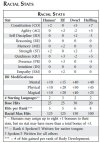
Start were 1-100, but the bonuses were more like those found in RMSS, smaller, cause they were outright additive (not averaged like in RM2).
the Racial decriptions included one or more Backgrounds that looked like this:
Barbarian: Athletics (2), Body Development (2), Combat Skills (3), Crafting (2), General Lore: Local Region (2), Maneuvering in Armor (2), Navigation (1), Perception (2), Stealth (2), Tracking (2)
Rural: Athletics (2), Body Development (2), Crafting (2), Combat Skills (2), General Lore: Local Region (2), Linguistics (6), Maneuvering in Armor (2), Perception (2), Navigation (1), Riding (1), Stealth (1)
These were basically starting ranks in skills based on their culture.
Each race also had several special abilities (for example, humans for to place 8 different +1 bonuses in their stats (in the bonuses, not the stat values), where Dwarves had Darkvision
Statss - as mentioned they were from 1-100 and you had both Temp and Potential.
You could use the array we gave, or use a random method (40 + 6d10 roll for each stat), so the absolute minimum would be 46, while the max would be 100.
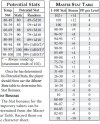
Hit points were the total of the Body Development skill
Power Points for spells would have been 5 + Realm Stat Bonus + PP/Lvl from the table above.
Resistance Rolls were as follows:
Mental = Level Mod + Presence + Self Discipline
Physical = Level Mod + Constitution + Self Discipline
Physical = Level Mod + Empathy+ Intuition
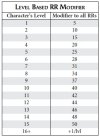
You also get Development Points to make your character. You start with 70 to spend -- once those are spent, you are first level and have 10,000 XP total
Each time, you go up a level, you get another 35 DPs...
You have several things to spend them on -- Skills, Training Packages, and Gifts.
Skill costs were also based on Profession, just like previous RM
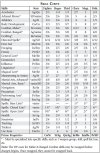
As seen, only 6 Professions starting out and a small skill list, which would be expanded later....
Skill Rank bonuses would be like RM3, basically 5/2/1/0.1 (10 ranks per division).
the Combat skills were ot be learned in groups
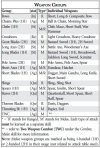
Now for each group, you selected a Primary Weapon and got your full skill bonus in it, all other wepaons in the group were -10. If you tried to use a weapon in a group you no skill in, you would get -35 (-10 for no primary, -25 for no ranks) to your best weapon skill for that group. Each group would be a separate skill, just like spell lists, lore skills and Martial Arts
Martial arts basically had 3 sub-skills (Strikes, Sweeps & Throws, Wrestling/Grappling, the advanced versions could not be higher than the normal, and gave you a larger size attack.
During development you can also purchase Training packages, there are about 8 to select from. Training packages have SIMPLE creation rules and cost 5 + # of skill ranks in DPs.
You can also spend Development Points on Gifts. there is a list of 12 in the core rules... For example, you could spend 10 to get an Extra Base Spell List or to have Dark Vision if you do not already have it
Note: Cleric and Magician get 10 Base Lists, we give six and then they choose 4 from open and closed lists to be base lists (this affects their costs). Semi-spell users get 6 Base lists, they can choose from the 6 provided and/or the Open and Closed lists (i.e. they could choose a Closed List as one of their Base) -- any pre-defined Base List not chosen would be treated as a Closed List)
Armor would be by the piece, in a truncated fashion (body, pauldrons, bracers, Greaves, helms)
DB = 10 + (2 x Quickness Bonus) + modifiers
Initiative = 2d10 + Quickness bonus + Mods
The weapon table gives modifiers for the attack tables

The attack tables have a column for every type of base armor
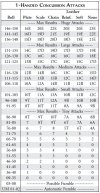
The crit tables are single column tables like those found in RMX, so that they could be later expanded into an Arms law product.
Spell lists went up to 10th level, and I was planning on making sure that none of them had blanks in them, also to be expanded to 50th level in Spell Law, and more lists added overall.
The Creatures and Treasures section had some encounter tables, a starter selection of monsters (33 monsters)
there are two small treasure generation tables as well (one table for money, one for magical items)
and finished up with a 2 page character sheet, and a 3 page index.
 roposed RM Revision Plan&fn=24April22 -- and in that product plan, I guestimated 128 pages. The final PDF was 130 pages, not including a cover. This got canceled by Seal at the last minute for being "too much like HARP"
roposed RM Revision Plan&fn=24April22 -- and in that product plan, I guestimated 128 pages. The final PDF was 130 pages, not including a cover. This got canceled by Seal at the last minute for being "too much like HARP"The only HARP-like thing in it were the names of the Resistance Rolls -- they still worked like in previous RM versions.
Note that this was never published! Nor am I allowed to share it out...
THe core book would have had 4 races

Start were 1-100, but the bonuses were more like those found in RMSS, smaller, cause they were outright additive (not averaged like in RM2).
the Racial decriptions included one or more Backgrounds that looked like this:
Barbarian: Athletics (2), Body Development (2), Combat Skills (3), Crafting (2), General Lore: Local Region (2), Maneuvering in Armor (2), Navigation (1), Perception (2), Stealth (2), Tracking (2)
Rural: Athletics (2), Body Development (2), Crafting (2), Combat Skills (2), General Lore: Local Region (2), Linguistics (6), Maneuvering in Armor (2), Perception (2), Navigation (1), Riding (1), Stealth (1)
These were basically starting ranks in skills based on their culture.
Each race also had several special abilities (for example, humans for to place 8 different +1 bonuses in their stats (in the bonuses, not the stat values), where Dwarves had Darkvision
Statss - as mentioned they were from 1-100 and you had both Temp and Potential.
You could use the array we gave, or use a random method (40 + 6d10 roll for each stat), so the absolute minimum would be 46, while the max would be 100.

Hit points were the total of the Body Development skill
Power Points for spells would have been 5 + Realm Stat Bonus + PP/Lvl from the table above.
Resistance Rolls were as follows:
Mental = Level Mod + Presence + Self Discipline
Physical = Level Mod + Constitution + Self Discipline
Physical = Level Mod + Empathy+ Intuition

You also get Development Points to make your character. You start with 70 to spend -- once those are spent, you are first level and have 10,000 XP total
Each time, you go up a level, you get another 35 DPs...
You have several things to spend them on -- Skills, Training Packages, and Gifts.
Skill costs were also based on Profession, just like previous RM

As seen, only 6 Professions starting out and a small skill list, which would be expanded later....
Skill Rank bonuses would be like RM3, basically 5/2/1/0.1 (10 ranks per division).
the Combat skills were ot be learned in groups

Now for each group, you selected a Primary Weapon and got your full skill bonus in it, all other wepaons in the group were -10. If you tried to use a weapon in a group you no skill in, you would get -35 (-10 for no primary, -25 for no ranks) to your best weapon skill for that group. Each group would be a separate skill, just like spell lists, lore skills and Martial Arts
Martial arts basically had 3 sub-skills (Strikes, Sweeps & Throws, Wrestling/Grappling, the advanced versions could not be higher than the normal, and gave you a larger size attack.
During development you can also purchase Training packages, there are about 8 to select from. Training packages have SIMPLE creation rules and cost 5 + # of skill ranks in DPs.
You can also spend Development Points on Gifts. there is a list of 12 in the core rules... For example, you could spend 10 to get an Extra Base Spell List or to have Dark Vision if you do not already have it
Note: Cleric and Magician get 10 Base Lists, we give six and then they choose 4 from open and closed lists to be base lists (this affects their costs). Semi-spell users get 6 Base lists, they can choose from the 6 provided and/or the Open and Closed lists (i.e. they could choose a Closed List as one of their Base) -- any pre-defined Base List not chosen would be treated as a Closed List)
Armor would be by the piece, in a truncated fashion (body, pauldrons, bracers, Greaves, helms)
DB = 10 + (2 x Quickness Bonus) + modifiers
Initiative = 2d10 + Quickness bonus + Mods
The weapon table gives modifiers for the attack tables

The attack tables have a column for every type of base armor

The crit tables are single column tables like those found in RMX, so that they could be later expanded into an Arms law product.
Spell lists went up to 10th level, and I was planning on making sure that none of them had blanks in them, also to be expanded to 50th level in Spell Law, and more lists added overall.
The Creatures and Treasures section had some encounter tables, a starter selection of monsters (33 monsters)
there are two small treasure generation tables as well (one table for money, one for magical items)
and finished up with a 2 page character sheet, and a 3 page index.



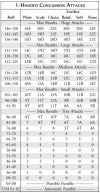
 .
.
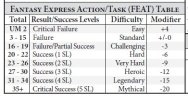
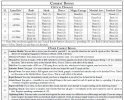


 .
.